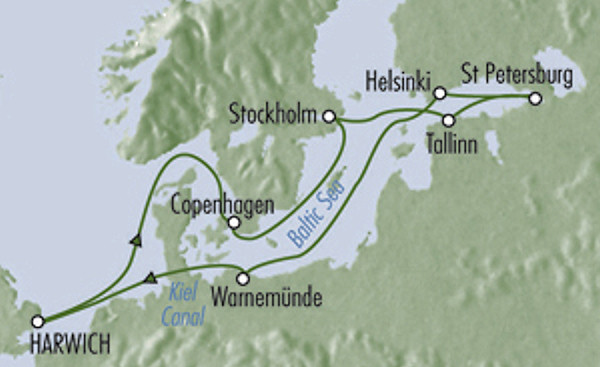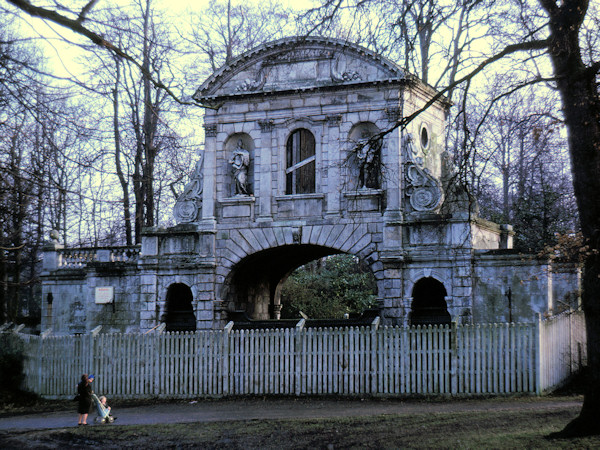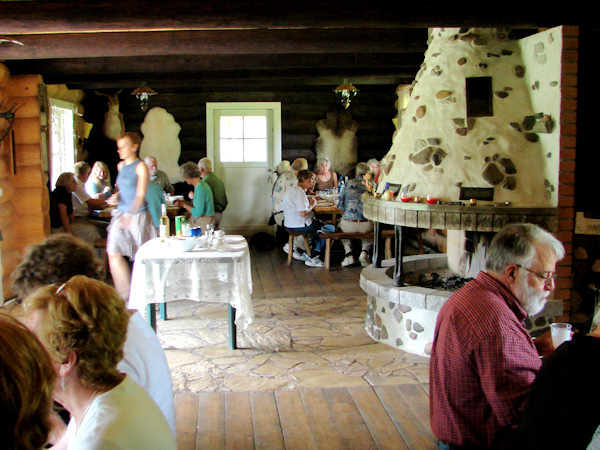

| London (& Harwich) | |
| The
Temple Bar describes the western-most boundary of the City of London,
where Fleet Street (in the City) becomes the Strand (in greater London). In 1669, Christopher Wren started a 3-year construction project that resulted in a limestone gateway at that point. That gateway now stands adjacent to the main front of St. Pauls Cathedral, a major Wren masterpiece. (Notice Janet in the lower left corner.) There is more to this story, though. | |
| In
1878, the City dismantled this gate, just as all the other gates had
been dismantled years before. They were all impediments to
traffic. The gate, in 2700 pieces, was purchased by a brewer and landowner in Hertfordshire, and he reassembled it as the gateway to his estate, Theobald's Park. This placed it about 5 ½ miles from our home in Broxbourne. So, in 1964 we went over to see it. (Janet, Doug and Graham Jaggs are in the lower left corner.) In 2001, the decrepit Temple Bar was acquired by a trust in London for £1. By 2004 it was repaired and reassembled near St. Pauls. |  |
| Here
is a view of St. Pauls Cathedral as seen from the Tate Modern Museum.
The Millennium Bridge, designed by Foster and Partners,
appears in the foreground. While this is a suspension bridge, the
cables are all low, to keep the view clear. Down river from here, there is a Norman Foster Greater London County hall, but we didn't see it on this trip. | |
| With a new County Hall, the old County Hall (1922) has been turned into a tourist site, and it includes an aquarium, an arcade and a hotel. This is on the south side of the Thames, just down river from the Lambeth Bridge. | |
| Almost in front of the 1922 County Hall, you see the London Eye, which started turning in 1999. We have been to London about five times since then, and still we have never been up. It is not the height (443 feet), but the crowds that have kept us away. | |
| I was determined to have some "pub grub" on this trip, and the Marquis of Granby was close to the hotel in Westminster. They had all types of meat pies, starting with steak and kidney pie. Pie and ale, that makes lunch. | |
| But this is a cruise. We got on the MV Discovery in the Port of Harwich, and as we left, we sailed right past the old town of Harwich. The town was chartered in 1228, and it used to be used by the Royal Navy. Now it is purely a commercial port, but the old quay and the Pier Hotel look like a nice place to visit. | |
| Copenhagen, Denmark | |
| As you sail into Copenhagen, Elsinore Castle appears on the right. Shakespeare placed Hamlet here. Actually,
the proper Danish name is Kronborg Slot, and most of this structure
post dates the 1600 play, because there was a big fire in 1629 that
destroyed everything but a chapel. The Danish kings used this as a site to collect taxes from passing ships. | |
| The Amalienborg Palace consists of four, nearly identical buildings in Rococo style, built around 1760. They face a large paved square. Each of them has been occupied by one Danish king or the other. Most are named either Frederick or Christian. | |
| Copenhagen's City Hall dates to 1905, but its National Romantic style has come from Sienna. I missed its 340-foot tall clock tower in this picture. | |
| Grundtvigs Church is named after the Danish philosopher, Nikolai Grundtvig. It was built in the 1920's, and the architecture is described as "expressionist." It is a fusion of Gothic and Scandinavian styles. The material is yellow brick, which is a native material. The church is Lutheran, and it is very sere inside. No Catholic ornamentation here. | |
| The most ornamental part of Grundtvigs Church is its organ. This is a relatively modern instrument, built in 1965. Somewhere back there is the longest organ pipe in all Scandinavia. This picture also shows the strong Gothic influence in the columns and vaulting. | |
| The Peacock Theater in Tivoli Gardens was opened very shortly after the Gardens opened in 1874. The theater is used primarily for pantomimes (accompanied by an orchestra), but it has also hosted the Royal Danish Ballet and jazz concerts. The peacock screen is mechanical, and five stagehands are required to open and close it. | |
| Tivoli
Gardens is probably the most iconic landmark in Copenhagen. It
represented some of the inspiration for Disneyland. (My first
thought was to say it resembled Disneyland, but that violates
causality.) This is the principal path in and out of the park, seen at dusk. | |
| Stockholm, Sweden | |
| When you dock in Stockholm, you are viewing Gamla Stan (which should be familiar to all of us from The Girl With A Dragon Tattoo). This is the old, original Stockholm, and it is one of 14 islands that now make up the city. The large monolith on the right is the 605 room royal palace. | |
| The Old Town is laced with narrow streets, like this one. Some follow old town walls; some supported fortifications. | |
| The Old Square (Storatorget) in the Old Town was the site of mass beheadings in 1520, but now it is a key hub for shopping and al fresco drinking. | |
| On one side of the Storatorget, you find the Swedish Academy, which takes responsibility for naming all the Nobel Prize winners, with the exception of the Peace Prize. Alfred Nobel assigned that responsibility to Norway. | |
| The Nobel Prizes are actually presented in Stockholm's City Hall, a 1923 brick structure, with a modern feel about it. | |
| This is Blue Hall in the City Hall. Every
year, 1300 guests are here for the Nobel Banquet. In the far
corner is a console for a 10,000 pipe organ. The pipes are mostly
hidden in the walls, and in a balcony out of view on the right. Sunlight from a window forced me to bleach out a number of people so we can see the room. | |
| The German Church was built around 1878, and its style is Baroque. This structure
is known as the King's Gallery, and it sits about 20 feet from the
pulpit, not quite visible on the left. There is a monogram that
makes reference to King Charles XI of Sweden. So much for Lutheran restraint. | |
| The Vasa was a Swedish warship that sank less than 2 miles into its maiden voyage in 1628. It was raised in remarkably good shape in 1961, and it now resides in its own, very popular, Vasa Ship Museum in Stockholm. | |
| Stockholm also has Tivoli Gardens, but arguably much less famous than Copenhagen's. This park is actually very close to the Vasa museum. | |
| Stockholm is described as an archipelago , so as you sail out, the ship passes among dozens of islands of all sizes. Most have graceful little havens, like this. | |
| Tallinn, Estonia | |
| As we went through the Baltic Sea, we kept finding the Holland America Eurodam beside us at the docks. It wasn't until Tallinn that we got a good comparison. The Eurodam carries 2250 passengers, and Discovery carries 650. | |
| There is a tradition of choral singing in Estonia, but this took a critical turn in 1987 and 1988, when the song festival included patriotic songs forbidden by the occupying Russians. 300,000 participated here, and that was about a third of the non-Russian residents of Estonia. | |
| In the distance, we could see the TV tower that figured in Estonia's bloodless overthrow of the Russians.
Two things happened more or less at the same time (August
20, 1991): Russian troops failed in their attempt to take control
of this tower, and Boris Yeltsin put down a Communist coup attempt in Moscow, sustaining glasnost. Estonia became an independent country through the bloodless Singing Revolution. Now it is a country of about 1.3 million people, 75% of the population of Santa Clara County. | |
| This pink building, but not the blond with the brochures, figured strongly in the Singing Revolution. This is the Toompea Palace, where the Estonian parliament sits. Not too surprisingly, between 1988 and 1991, it was the site of several confrontations with the Russians. | |
| The Alexander Nevsky Cathedral is almost directly across from Toompea Palace, and it continues to serve a sizable Russian minority in Estonia. Actually, Estonia is not a very religious country, with ¾ of the people claiming no specific religion. | |
| This
is the German Cathedral that gives the region known as Toompea its
name, but it is now a museum. Fitting for a non-religious country. German for the area was Dom Berg, meeting cathedral mountain, but when it got into Fino-Urgic Estonian, that became Toompea. | |
| The
Toompea is actually a limestone crag that stands 80 or 100 feet above
most of the old town of Tallinn. Looking out over the old town,
St. Olaf's Church, dominates the landscape. Prior to 1625, at 522
feet, it was the tallest building in the world. Why 1625?
Lightning struck and burned it down. This church, named for a Norwegian king, now serves a Baptist congregation. | |
| The
route from the high mound of Toompea down to the rest of the old town
is steep. Tallinn's Old Town was historically a Hansiatic town,
and its unification with Toompea is fairly recent. Note the
medieval gate that once marked the separation. St. Olaf's tall tower was a navigational aid for the Hansiatic traders. | |
| This Tallinn's old city hall, dating to 1404. Its tower was destroyed by bombing in 1944, and we see a 1950 restoration here. This is the heart of the Old Town. | |
| The town hall faces a large square, and it is a busy commercial center. Particularly for tourists. Actually, at number 11, the Town Hall Pharmacy continues to operate. According to Wikipedia, folks think it first opened in 1415. | |
| After the urban wonders of Tallinn, we went out into the country to have lunch at a working farm, but their profit margin depends upon tourists like our group. |  |
| Return to Home Page | Forward to Part 2 (St. Petersburg and more) |